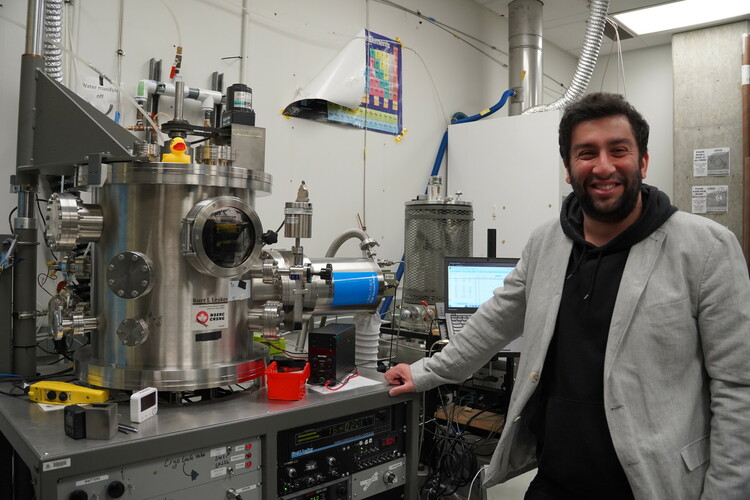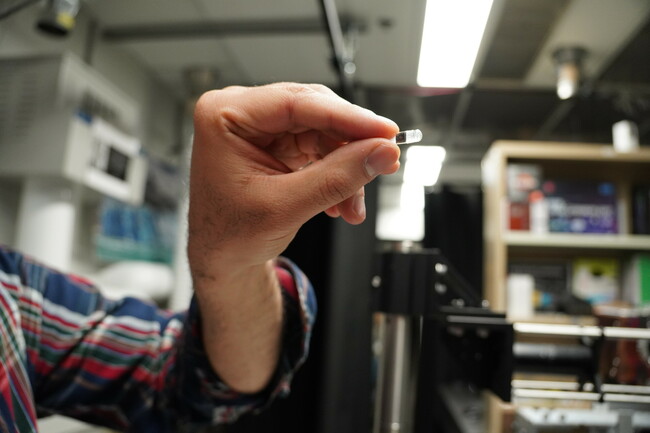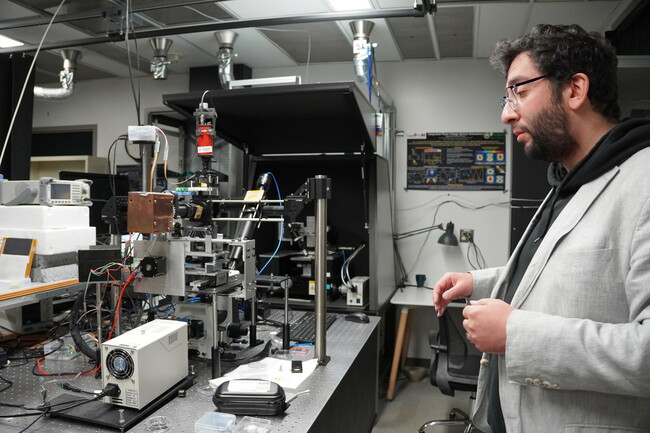Butterfly wings and asymmetric transmission: the road to higher efficiency, colourful solar cells
Posted on
Dr. Behrad Gholipour in his lab, Nanoscale Optics Lab
Solar cells are being used to harvest renewable energy. Butterfly wings are renowned for their beauty. Neither seems connected to the advancement of energy technology––until you consider them at the nanoscale.
Dr. Behrad Gholipour is bringing together key concepts from metamaterials and metasurfaces to develop surfaces for photovoltaic cells that will perform efficiently no matter what their angle to the sun. And the applications don’t stop there.
Dr. Gholipour began his educational journey at the University of South Hampton, a British university known for its development and advancement of fibre optics and metamaterial technology. His academic career has taken him from England to Singapore to Canada, where he is now a professor in the Department of Electrical and Computer Engineering at the University of Alberta. He currently runs the Gholipour Group out of the Nanoscale Optics Lab, a research team focused on nanotechnology, and in particular, nanophotonics.

What are metamaterials and metasurfaces?
Metamaterials are any material that can be engineered to portray any property that very rarely occurs in nature. They have unique physical structures that are smaller than the light wavelengths they are trying to manipulate. This differs from materials found in nature, whose properties are dictated by chemical bonds and composition.
Rather than electromagnetic waves—or light—passing through a 3-dimensional material, metasurfaces manipulate light through a 2-dimensional surface. Think of it like a type of counterpart that light can pass through. Unlike metamaterials, metasurfaces can be structured or unstructured on subwavelength scaled-patterns. Both metamaterials and metasurfaces can produce the ability to manipulate or deflect light waves and have a place in Behrad’s world of nanoscale photonics.
Here Comes the Sun
There are two types of solar cells: central solar power, which uses mirrors to capture sunlight, and photovoltaic cells, which implement the photovoltaic effect. In the context of solar energy generation, metamaterials and metasurfaces have been considered a suitable possibility since the early 2000s, due to their design versatility and scaling potential.
One type of metamaterial Dr. Behrad Gholipour is working with are based on chalcogenide semiconductors, which can be a metallic or glass phase-change material. Some properties include large composition space, low volatility, nonlinearity, photosensitivity, and infrared transparency—meaning that these semiconductors are reconfigurable, can withstand drastic temperature changes and are excellent for capturing electromagnetic waves.
In their manufactured form, these metamaterials and metasurfaces are an important part of photonic technology platforms. Their properties can be engineered to result in a phenomenon known as asymmetric transmission. Essentially, this means that depending on the direction of incoming light—or angle of incidence—the device will respond differently. For example, a device can be engineered so that when you shine the light in one direction it will act transparent, compared to when you shine light onto the device from the other direction it will act opaque: the device’s transmission response is therefore asymmetric.
Dr. Gholipour explains asymmetric transmission using a butterfly wing analogy:
“The colours in butterfly wings aren’t created by dyes, but are instead made up of tiny nanostructures that manipulate and filter the reflected light, creating the variety of colours we’re accustomed to seeing on the wings. In the case of our FES project, we create tiny nanostructures that can manipulate the light for transmission purposes. We can design them to show asymmetric transmission.”
Asymmetric transmission solves a major challenge of current PV cell technology: light reflecting off the surface of a cell leading to significant energy loss. Behrad and his team have created a roadmap and used it to identify some of the materials alloys of sulfur, selenium and tellurium. Although Behrad and his team are currently testing the best material and design for this layer. The beauty of the metamaterial platform is that any material can be used to maximize efficiency in any PV device to some degree.

Inspiration and A Big Brain Power Team
Unsurprisingly, the diversity of the concepts behind Dr. Gholipour’s research has led him to assemble a team from many backgrounds, with expertise in materials science, advanced mathematics, chemistry, physics, and software and electrical engineering.
“The research is highly multidisciplinary and interdisciplinary. We need to be masters in many trades to solve problems within the world of nanophotonics, and this makes what we do uniquely exciting in my view.”
But putting a team of the right people together gets results. By next year, Dr. Gholipour is hoping for a working prototype of his new PV cell, and his long-term goal is commercialization.
He sees a particular opportunity in integrating PV cells into building facades to help facilitate a type of energy-independent architecture—buildings that can sustain their own energy usage through solar energy.
That approach could have benefits outside energy generation as well, for example in greener telecommunication platforms: “We can actually see the data farms from space because of how much thermal energy is being lost to store massive amounts of data. “The application of nanophotonics in this realm will significantly decrease how much energy is lost to heat waste.”
Taken together, the opportunities in nanophotonics are immense, and while the advancements may start with a more efficient photovoltaic cell for our everyday use, the eventual outcome could be a much more efficient world.
“This isn’t just technology for today,” he concludes. “We’re making a device that’s adaptive for tomorrow.”
Further readings:
Computing and Telecommunication Platforms with Dr. Behrad Gholipour
Photovoltaic effect - Energy Education
Roadmap on chalcogenide photonics - IOPscience